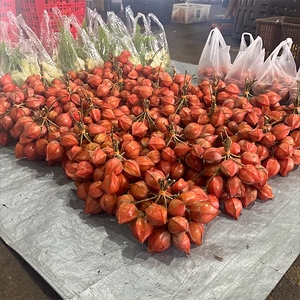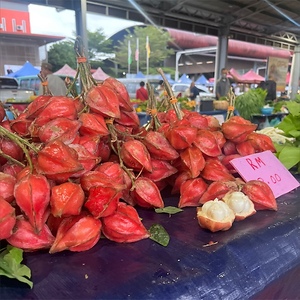


Belimbing Hutan
Estimated Inventory, lb : 0
Description/Taste
Belimbing Hutan is an ovoid, star-shaped fruit with a tapering tip, averaging 2 to 3 centimeters in diameter and 5 to 6 centimeters in length. Its skin transitions from dark purple to bright red when mature and has a leathery and spongy texture with black angular panels. When the thick skin is peeled away, its flesh is divided up into 1 to 3 segments and resembles garlic cloves. This flesh has a translucent white hue and tear-drop shape. There are several flat, light brown seeds adhered tightly to the center of the flesh. Belimbing Hutan has a sweet aroma and taste, with juicy, tangy flavor notes and tropical nuances similar to mangosteen.
Seasons/Availability
Belimbing Hutan is available from fall to winter.
Current Facts
Belimbing Hutan, botanically classified as Baccaurea angulata and belonging to the Phyllanthaceae family, is a rare fruit that grows on the trunk and branches of a perennial tree in the jungles of Borneo. Its name roughly translates to red star fruit in English and it's known for having a sweet and sour taste. This fruit is also called Ucong, Belimbing Api, Belimbing Merah, Asam Ketiak, and Tempoi Huton. Belimbing Hutan trees are extremely prolific and can grow hundreds of tightly clustered fruits on a single tree. The flowers that bloom from the tree’s branches are used ornamentally as a vibrant table decoration and attract pollinators like bees.
Nutritional Value
Belimbing Hutan's vitamin C content boosts immune function, collagen production, skin health, iron absorption, and wound healing. The fiber in this fruit promotes digestive health, weight management, stable blood sugar and cholesterol levels, and beneficial gut bacteria. As a source of potassium, Belimbing Hutan may help regulate blood pressure, support muscle function, maintain fluid balance, improve bone health, and promote cardiovascular wellness. This fruit contains magnesium, a nutrient crucial for bone development, muscle and nerve function, heart health, energy production, and improving sleep quality. The calcium sourced from Belimbing Hutan fruit is vital for strong bones and teeth, muscle contraction, blood clotting, nerve transmission, and hormone regulation.
Applications
Belimbing Hutan is best suited for fresh consumption but can also be cooked, boiled, or preserved for later use. This fruit is frequently peeled and consumed plain or sprinkled with chili salt. The flesh is often juiced and consumed as a drink, smoothie, or infused into teas. Belimbing Hutan may be thinly sliced into green or fruit salads with mangoes, pineapple, papaya, oranges, strawberries, passion fruit, watermelon, peaches, plums, dragon fruit, and lychee. It can be pickled into a sour relish with spices, vinegar, and sugar. When pickled, the skin becomes edible and is commonly preserved with sweet syrups to add flavor. This fruit adds a tangy sour taste to curries, sauces, and soups. It's easily incorporated into jams, jellies, chutneys, salsas, and sour candies. Belimbing Hutan will keep for 2 to 3 days when left in a cool, dry place. It will last for 2 to 3 months when placed in the freezer.
Ethnic/Cultural Info
The Belimbing Hutan tree has many uses for the native Bornea people living amongst it in Southeast Asia. The wood from the tree is used for making decorations, building tools, and for landscape design in parks and gardens. The fruit is often used as a flavoring agent and also serves as a table decoration because of its unique shape. The flowers from the Belimbing Hutan plant have been used medicinally to treat headaches, fevers, constipation, abdominal pain, arthritis, eye swelling, and respiratory issues.
Geography/History
Belimbing Hutan is native to the tropical, humid climate of the island of Borneo in Southeast Asia. It grows at elevations up to 800 feet in rainforests, lowland and hill forests, along riverbanks, and in areas where the forest has regrown. This fruit is relatively obscure and is thus not commonly grown commercially or in home gardens. It’s most often procured through foraging. Outside of the local farmers’ markets in Borneo, the only other place where Belimbing Hutan is likely to be found is in a few select markets across Indonesia.










